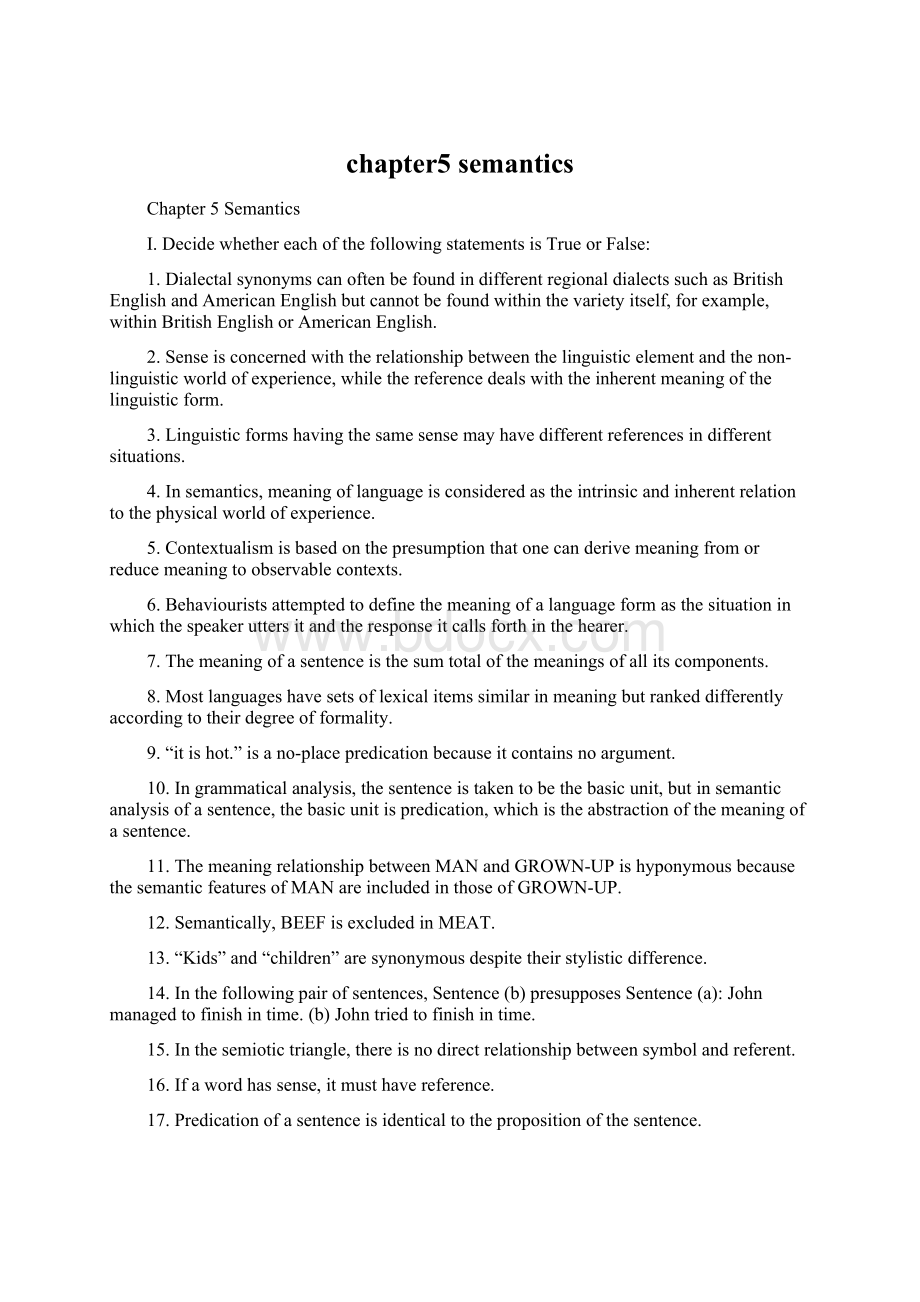chapter5 semantics.docx
《chapter5 semantics.docx》由会员分享,可在线阅读,更多相关《chapter5 semantics.docx(9页珍藏版)》请在冰豆网上搜索。

chapter5semantics
Chapter5Semantics
I.DecidewhethereachofthefollowingstatementsisTrueorFalse:
1.DialectalsynonymscanoftenbefoundindifferentregionaldialectssuchasBritishEnglishandAmericanEnglishbutcannotbefoundwithinthevarietyitself,forexample,withinBritishEnglishorAmericanEnglish.
2.Senseisconcernedwiththerelationshipbetweenthelinguisticelementandthenon-linguisticworldofexperience,whilethereferencedealswiththeinherentmeaningofthelinguisticform.
3.Linguisticformshavingthesamesensemayhavedifferentreferencesindifferentsituations.
4.Insemantics,meaningoflanguageisconsideredastheintrinsicandinherentrelationtothephysicalworldofexperience.
5.Contextualismisbasedonthepresumptionthatonecanderivemeaningfromorreducemeaningtoobservablecontexts.
6.Behaviouristsattemptedtodefinethemeaningofalanguageformasthesituationinwhichthespeakeruttersitandtheresponseitcallsforthinthehearer.
7.Themeaningofasentenceisthesumtotalofthemeaningsofallitscomponents.
8.Mostlanguageshavesetsoflexicalitemssimilarinmeaningbutrankeddifferentlyaccordingtotheirdegreeofformality.
9.“itishot.”isano-placepredicationbecauseitcontainsnoargument.
10.Ingrammaticalanalysis,thesentenceistakentobethebasicunit,butinsemanticanalysisofasentence,thebasicunitispredication,whichistheabstractionofthemeaningofasentence.
11.ThemeaningrelationshipbetweenMANandGROWN-UPishyponymousbecausethesemanticfeaturesofMANareincludedinthoseofGROWN-UP.
12.Semantically,BEEFisexcludedinMEAT.
13.“Kids”and“children”aresynonymousdespitetheirstylisticdifference.
14.Inthefollowingpairofsentences,Sentence(b)presupposesSentence(a):
Johnmanagedtofinishintime.(b)Johntriedtofinishintime.
15.Inthesemiotictriangle,thereisnodirectrelationshipbetweensymbolandreferent.
16.Ifawordhassense,itmusthavereference.
17.Predicationofasentenceisidenticaltothepropositionofthesentence.
18.Aftercomparing“Theystoppedattheendofthecorridor”with“Attheendofthecorridor,theystopped”,youmayfindsomedifferenceinmeaning,andthedifferencecanbeinterpretedintermsofcollocativemeaning.
19.“Tulip”,“rose”and“violet”areallincludedinthenotionof“flower”,thereforetheyaresuperordinatesof“flower”.
20.Thetheoryofmeaningwhichrelatesthemeaningofawordtothethingitrefersto,orstandsfor,isknownasthereferentialtheory.
II.Fillineachofthefollowingblankswithonewordwhichbeginswiththelettergiven:
21.S________canbedefinedasthestudyofmeaning.
22.Theconceptualistviewholdsthatthereisnod______linkbetweenalinguisticformandwhatitrefersto.
23.R______meanswhatalinguisticformreferstointhereal,physicalworld;itdealswiththerelationshipbetweenthelinguisticelementandthenon-linguisticworldofexperience.
24.Wordsthatarecloseinmeaningarecalleds________.
25.Whentwowordsareidenticalinsound,butdifferentinspellingandmeaning,theyarecalledh__________.
26.R_________oppositesarepairsofwordsthatexhibitthereversalofarelationshipbetweenthetwoitems.
27.C____analysisisbaseduponthebeliefthatthemeaningofawordcanbedividedintomeaningcomponents.
28.Whetherasentenceissemanticallymeaningfulisgovernedbyrulescalleds________restrictions,whichareconstraintsonwhatlexicalitemscangowithwhatothers.
29.Ana________isalogicalparticipantinapredication,largelyidenticalwiththenominalelement(s)inasentence.
30.Accordingtothen____theoryofmeaning,thewordsinalan-guagearetakentobelabelsoftheobjectstheystandfor.
III.Therearefourchoicesfollowingeachstatement.Markthechoicethatcanbestcompletethestatement:
31.Thenamingtheoryisadvancedby________.
A.Plato B.Bloomfield
C.GeoffreyLeech D.Firth
32.“Weshallknowawordbythecompanyitkeeps.”Thisstatementrepresents_______.
A.theconceptualistview B.contexutalism
C.thenamingtheory D.behaviourism
33.Whichofthefollowingisnottrue?
A.Senseisconcernedwiththeinherentmeaningofthelinguisticform.
B.Senseisthecollectionofallthefeaturesofthelinguisticform.
C.Senseisabstractandde-contextualized.
D.Senseistheaspectofmeaningdictionarycompilersarenotinterestedin.
34.“CanIborrowyourbike”_______“Youhaveabike.”
A.issynonymouswith B.isinconsistentwith
C.entails D.presupposes
35.___________isawayinwhichthemeaningofawordcanbedissectedintomeaningcomponents,calledsemanticfeatures.
A.Predicationanalysis B.Componentialanalysis
C.Phonemicanalysis D.Grammaticalanalysis
36.“alive”and“dead”are______________.
A.gradableantonyms B.relationalopposites
C.complementaryantonyms D.Noneoftheabove
37._________dealswiththerelationshipbetweenthelinguisticelementandthenon-linguisticworldofexperience.
A.Reference B.Concept
C.Semantics D.Sense
38.___________referstothephenomenonthatwordshavingdifferentmeaningshavethesameform.
A.Polysemy B.Synonymy
C.Homonymy D.Hyponymy
39.Wordsthatarecloseinmeaningarecalled______________.
A.homonyms B.polysemy
C.hyponyms D.synonyms
40.Thegrammaticalityofasentenceisgovernedby_______.
A.grammaticalrules
B.selectionalrestrictions
C.semanticrules
D.semanticfeatures
IV.Definethefollowingterms:
41.semantics 42.sense
43.reference 44.synonymy
45.polysemy 46.homonymy
47.homophones 48.Homographs
49.completehomonyms 50.hyponymy
51.antonymy 52componentialanalysis
53.grammaticalmeaning 54.predication
55.Argument 56.predicate
57.Two-placepredication
V.Answerthefollowingquestions:
58.Whydowesaythatameaningofasentenceisnotthesumtotalofthemeaningsofallitscomponents?
59.Whatiscomponentialanalysis?
Illustrateitwithexamples.
60.Howdoyoudistinguishbetweenentailmentandpresuppositionintermsoftruthvalues?
61.Howdoyouaccountforsuchsenserelationsbetweensentencesassynonymousrelation,inconsistentrelationintermsoftruthvalues?
62.Accordingtothewaysynonymsdiffer,howmanygroupscanweclassifysynonymsintoIllustratethemwithexamples.
63.WhatarethemajorviewsconcerningthestudyofmeaningHowtheydiffer?
64.Ofthefivesemanticrelationsamongsentences:
paraphrase,entailment,contradiction,presuoopsition,andtautology,whichoftheserelationsisexemplifiedineachofthefollowingpairsofsentencesorsentences?
A.IsawTimothyattheanniversaryparty.
ItwasTimothythatIsawattheanniversaryparty.
B.Theorphanhasnofather.
C.JulesisMary’shusband.Maryismarried.
D.Veraisanonlychild.OlgaisVera’ssister.
E.ThemayorofManchesterisawoman.
ThereisamayorinManchester.
65.Inthesentence“Isawhimonthebus”,therecanbethreeinterpretationsofthemeaning.Trytoanalyzethesentencetobringaboutyourdifferentinterpretations.GiveequivalentexpressionsinChinese,ifnecessary.
Chapter5Semantics
I.DecidewhethereachofthefollowingstatementsisTrueorFalse:
l.F 2.F 3.T 4.F 5.T 6.T 7.F 8.T 9.T 10.T
11.T12.F13.T14.T15.T16.F17.T18.F19.F20.T
II.Fillineachofthefollowingblankswithonewordwhichbeginswiththelettergiven:
21.Semantics22.direct23.Reference24.synonyms25.homophones26.Relational27.Componential28.selectional29.argument30.naming
III.Therearefourchoicesfollowingeachstatement.Markthechoicethatcanbestcompletethestatement:
3l.A 32.B 33.D 34.D 35.B 36.C 37.A 38.C 39.D 40.A
IV.Definethefollowingterms:
41.Semantics:
Semanticscanbesimplydefinedasthestudyofmeaninginlanguage.
42.Sense:
Senseisconcernedwiththeinherentmeaningofthelinguisticform.Itisthecollectionofallthefeaturesofthelinguisticform;itisabstractandde-contextualised.
43.Reference:
Referencemeanswhatalinguisticformreferstointhereal,physicalworld;itdealswiththerelationshipbetweenthelinguisticelementandthenon-linguisticworldofexperience
44.Synonymy:
Synonymyreferstothesamenessorclosesimilarityofmeaning.
45.Polysemy:
Polysemyreferstothefactthatthesameonewordmayhavemorethanonemeaning.
46.Homonymy:
Homonymyreferstothephenomenonthatwordshavingdifferentmean-ingshavethesameform,i.e.,differentwordsareidenticalinsoundorspelling,orinboth.
47.homophones:
Whentwowordsareidenticalinsound,theyarecalledhomophones
48.homographs:
Whentwowordsareidenticalinspelling,theyarehomographs.
49.completehomonyms.:
Whentwowordsareidenticalinbothsoundandspelling,theyarecalledcompletehomonyms.
50.Hyponymy:
Hyponymyreferstothesenserelationbetweenamoregeneral,moreinclusivewordandamorespecificword.
51.Antonymy:
Antonymyreferstotherelationofoppositenessofmeaning.
52.Componentialanalysis:
Componentialanalysisisawaytoanalyzewordmeaning.Itwaspro-posedbystructuralsemanticists.Theapproachisbasedonthebeliefthatthemeaningofa-wordcanbedividedintomeaningcomponents,whichareca